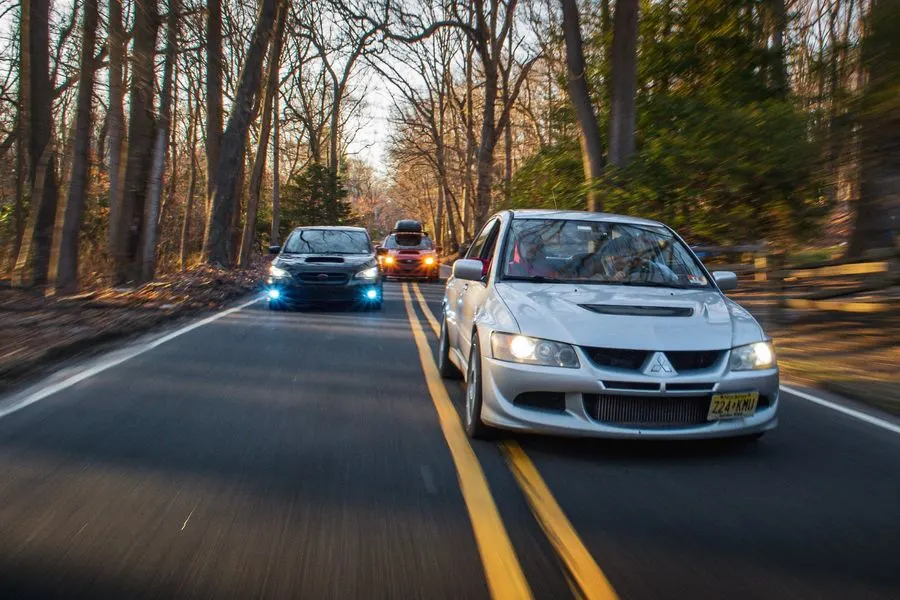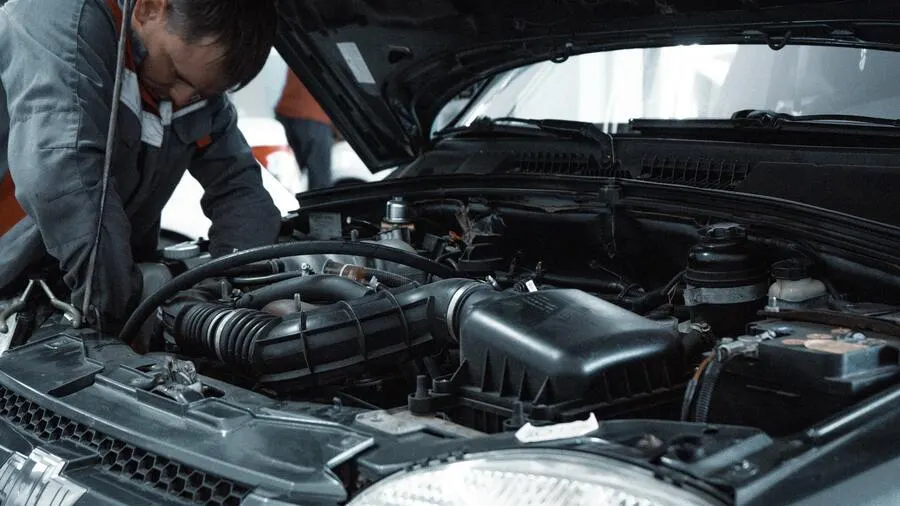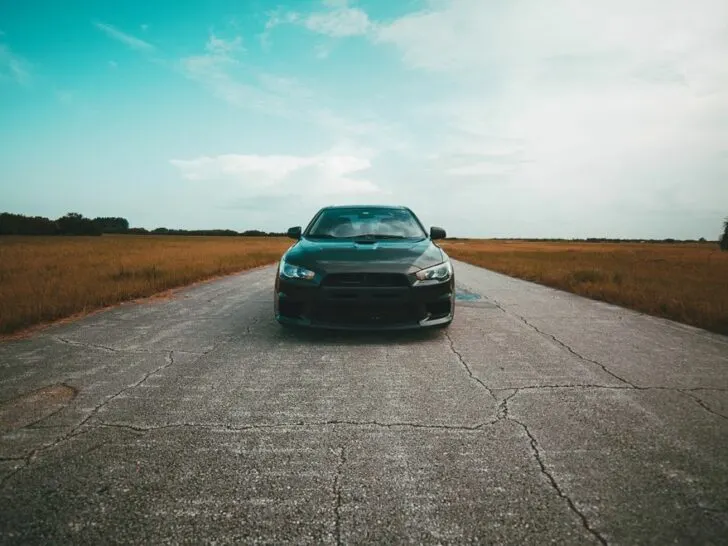The cars once used as rally cars and sports cars, which left the other racers behind in the rear-view mirror and a smile on the driver’s face, are still very demanding cars due to their speed and comfort for the races and as a normal driving car.
But the production has stopped for these masterpieces, which were also famous for their prices and compact sedans. The Lancer Evolution has an All-Wheel Drive, which makes it a powerful vehicle and a fast one, whereas the Mitsubishi Lancer has a Front-Wheel Drive, which it’s less powerful and pathetically slow.
Mitsubishi Lancer (Origin)
Mitsubishi Lancer was an automobile manufactured by a Japanese manufacturer known as Mitsubishi Motors in 1973. There is a total of nine Lancers models before the current one.
From its start in 1973 till 2008, it sold over six million units. Its production ended in 2017 worldwide, excluding China and Taiwan, because of its use by many Police officers in China.

Specifications
As some people say, it’s an ordinary family car, an entry-level sedan with a powerful engine that has 107 bhp to 141 bhp, which can vary from 0-60 in 9.4 to 11.2 seconds, which is outstanding if you compare it with its old models.
In terms of fuel economy, it gives about 35 to 44 mpg with a fuel capacity of 50 liters. With a manual Petrol/Diesel automatic petrol engine and a mileage of 13.7 kpl to 14.8 kpl
The length of the Lancer is about 4290 mm and has a width of 1690 mm with a 2500 mm wheelbase. And has a max torque of 132.3 Nm@3300 rpm.
The body style of a sedan makes it hard to sell nowadays in the US as it was once the most demanding car in the US. It would cost about $17,795 to $22,095 in MSRP. It also comes in 4 different stylish colors: Black Onyx, Simply Red, Warm Silver, and Scotia White.
It gives different mileage in different variants and different transmissions of Mitsubishi Lancer. The Lancer with a manual transmission and petrol engine gives mileage of about 13.7 kpl and if its transmission is automatic with the same engine type, it would give about the same mileage that is 13.7 kpl. But in contradiction, if the engine type is changed to diesel with manual transmission it would give about 14.8 mileage.
Reliability of the Mitsubishi Lancer
If we talk about its reliability, it’s fairly reliable as it has a score of 3.5 out of 5.0 and comes in 29th place out of the 36 reviewed compact sedans. It’s also a very fuel-efficient sedan model offered by Mitsubishi.
To make the service life of the car longer, its damaged parts should be replaced as soon as possible.
When Buying a Second-Hand Mitsubishi Lancer, What Should You Consider Checking For?
Maintenance History
You should check that the car is properly serviced and there are no defects and then ask for evidence of that service.
A Second Opinion
When buying a second-hand car, you should get an expert opinion from a local mechanic as he might give you a clear idea of its life or if is it worth the money rather than going into a Mitsubishi dealership.
Carfax Check
This will not do much but show a clear picture of any defects on the car, and should review the information to see any effects of the defects on the engine or transmission.
Any Other Previous Owners?
A basic rule of a second-hand buy is more the previous owner, so more the usage and eventually more the usage of the engine and other parts. If only one owner drove the full mileage of the car and then serviced it, they took good care of the car.
How Long Are You Planning on Keeping the Car?
If you are planning on keeping it for the long term, you should check the car thoroughly before buying.

Common Problems of Mitsubishi Lancer
Its introduction in 1973 was one of the best-known Japanese automobiles but its fame also awakened many problems due to which America ceased its production in 2017.
The 2008 model had the most complaints, but the 2011 model was the worst-rated compact sedan by Edmunds. Some of them are listed as:
- Light Problems
- Suspension Problems
- Wheels and Hubs
- Body and Paint Problems
- Transmission Problems
These are some of those problems consumers had to face and made the drivers unsatisfied and unsafe as some of them were endangering the driver and the passengers in the car.
Rusting on the Mitsubishi Lancer
Rusting on a Lancer was not that common if the car was less than ten years old. But from 2016 to 2021, many recalls were announced for the Lancer due to extensive corrosion on the car’s front subframe and low control arms.
These recalls of the car affected the Lancers that were sold from 2002 to 2010 in some states that used salts on roads in winter. If the car is not driven near the coast or on salted roads, its corrosion is comparable to other common cars.

Tips to Protect Your Mitsubishi Lancer
To protect your Lancer from rusting, you should consider these points:
- Wash your car regularly and dry it, including the interior and exterior, so any corrosion spot or dirt can be removed affecting your car.
- Repair any scratches or paint damage, as it could become a site for corrosion.
- You should park your car in the garage or put a car cover on your Lancer to protect it from bad weather, sunlight, and bird droppings.
- Lancer should be waxed twice yearly to make your car look clean and protect it from corrosion.
- If you will keep your Lancer for a long time, you should do a rustproofing treatment and a rust check.
Mitsubishi Lancer Evolution
As the name says, it was an evolution of the Mitsubishi Lancer, it was commonly referred to as Evo. Mitsubishi Lancer Evolution is a sports sedan and a rally car based on the Mitsubishi Lancer which was manufactured by the Japanese manufacturer Mitsubishi Motors.
A total of ten official variants have been announced to this date. Each model has a specific Roman numeral assigned to it. All of them use two-liter intercooled turbo, inline four-cylinder engines with All-Wheel Drive (AWD).
It was initially intended for the Japanese market. Still, the demand was so high that it ended up being offered by the Ralliart dealer network in the UK and many markets in the European market around 1998. It cost about an average of $33,107.79
Specification
Lancer Evo is way better than a Lancer in performance and style as it is sportier and also a rally car. Because of its powerful engine with a turbocharged 2.0-liter four-cylinder that provides 291 hp and 300 Nm torque with All-Wheel Drive, it only needs 4.4 seconds to jump from 0 to 60, the fuel type being petrol and transmission being automatic, giving a mileage of 15.0 kpl.
Its fuel tank capacity is about 55 liters, with a max speed of 240 km/h. Has a sedan body with a width of 1.801 m and a length of 4.505 m. A Mitsubishi Evo would cost somewhere between $30,000 to $40,000 due to its high demand and its production being cut off.

The Paul Walker Evo
One of the Lancer Evo was used in two Fast and Furious movies in which the actor Paul Walker drove the car in 2002. Paul Walker drove a House of Color Lime Green Mitsubishi Lancer Evolution VII hero car in some movie scenes, but it was mostly a standard Lancer Evo model.
Lancer Evo Used as a Drifting Machine
Lancer Evo was used for professional drifting by the orange team, who had mastered AWD drifting and were the most remarkable in D1 Grand Pix. It was also used in Tokyo Drift Fast and Furious.
With an engine of 2-liter turbocharged DOHC 4G63 with RMR air intake and exhaust systems, its front driveshafts would disconnect to make an AWD car drift-able, which eventually becomes an RWD car.
The Rarest Evo
Evo VII Extreme is the rarest Evo of them all; only 29 were manufactured, which also makes it a collectible. It was built by Ralliart UK and started its production in 1999.
The Evo Extreme was based on the RSII Model that had an outstanding 350 hp. It would go from 0 to 60 in 4 seconds and cost about £41,995.
Common Problems of Mitsubishi Lancer Evo
Slow Down Lights Coming On
This is a minor problem but is faced by many drivers in which check engine lights shine with a slowdown warning message, and many of the drivers ignore it.
Squeaking Noise
Owners of Lancer Evo hear a squeaking noise coming from the engine bay of the 4B1 engine. It becomes much louder on cold days, and the pitch would usually follow as the engine speed changes.
Engine Stalling and Cutting Off
Many cases have been reported about the engine stalling and even cutting off, this mostly happens when a driver accelerates from a standstill and after cruising at a constant speed.
Brakes Not Working
Sometimes, the brakes become hard this happens in the early versions of the car, which stops the driver from applying brakes, but from the driver’s point of view (POV), it looks like the brakes are not working.
These are some of the problems that an owner of a Lancer Evo faces almost every day, there are many more problems and complaints about the car. Overall, it’s a very good vehicle; these problems are common in every car.
The Difference Between Mitsubishi Lancer and Lancer Evolution
Lancer and Lancer Evo both are compact sedans, and you would think that they are the same. But no, they’re completely different as Lancer is a very slow family car whereas Lancer Evo is a more sporty and powerful car.
The Lancer was rated as the worst compact sedan in America, whereas the Lancer Evo was a total upgrade and was loved among the rally racers and the regular drivers.
Lancers usually have a 1.5 to 2.4L engine, which develops about 100 to 170 horsepower, but for the Lancer Evo, its power comes from 2L turbo engines, making a whopping 300 to 400 horsepower.
Mitsubishi Lancer and Lancer Evolution Consumer Review
Lancer is an ordinary family car and is given 6.4 out of 10 overall: a 4.9 for comfort, 6.0 for its performance, and 8.9 for safety but the reliability was 3.0 out of 5.0 which is why the car was rated the worst sedan.
The Lancer Evo is a sporty and performance car. It was given 9.5 out of 10 overall: comfort was given 9.2, interior design scored a solid 8, 9.9 for the performance (due to it being fast), and reliability was given a 9.7, making it way better than lancer.
Full-On Difference in Specifications
| Mitsubishi Lancer | Mitsubishi Lancer Evolution |
|---|---|
| 2.0L Inline-4 Gas Engine | 2.0L Turbo Inline-4 Gas Engine |
| 5-Speed Manual Transmission | 5-Speed Manual Transmission |
| Front-Wheel Drive (FWD) | All-Wheel Drive (AWD) |
| City: 24 MPG, Hwy: 33 MPG Fuel Economy | City: 17 MPG, Hwy: 23 MPG Fuel Economy |
| 15.5 gallons Fuel Capacity | 14.5 gallons Fuel Capacity |
| 148 hp @ 6000 rpm Horse Power | 291 hp @ 6500 rpm Horse Power |
| 145 lb-ft @ 4200 rpm Torque | 300 lb-ft @ 4000 rpm Torque |
| 2,888 lbs Weight | 3,527 lbs Weight |
| $22,095 Cost Price | $33,107.79 Cost Price |
Conclusion
- In my opinion, the Lancer is a great car, but for those who want a compact sedan for their family, it is safe and comfortable for the family while driving.
- Whereas the Lancer Evolution is a whole different car as it can be a sports car, a rally racing car, and a drifting machine. It became famous for rally racing, and as it entered the drifting industries, the Lancer Evo was featured in many fast and furious movies.
- Choosing the best car depends on the consumer as it depends if the consumer likes a sporty car or an ordinary car as both look similar in their body.

